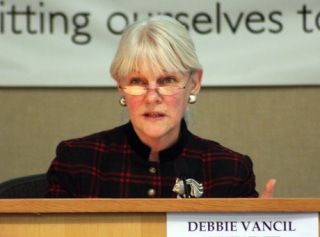The city council has identified the scale of cost reductions the city will begin to implement next week.
Council members agreed that there is a funding gap ranging between $3 to $6 million.
“Tonight we’re finding that gap. Next week we have to turn that gap into reduced expenses,” said council member Barry Peters.
The Wednesday evening session focused on reducing revenue assumptions and increasing the year-end cash balance. Cuts will be based on those agreed upon assumptions.
Current estimates for non-dedicated revenues in 2009 are $19.3 million. Conservative estimates brought forward by City Administrator Mark Dombroski last week estimated the city could see as little as $16.94 million in revenues this year.
Current estimates also predict there will be $1 million at the end of the year to cover the city’s rainy day emergency reserve. However, that million dollar reserve is dependent on the city selling the Head of the Bay property near the intersection of Wyatt Way and Eagle Harbor Drive.
“I keep iterating that the million is highly speculative, so don’t bank on it,” Dombroski said.
Council members agreed to increase their year-end revenue goals by $1 to $2.5 million in order to cover the city’s $2.2 million in reserves.
Council members also agreed that between $2 and $3.5 million needed to be slashed from current revenue assumptions in order to anticipate continued economic decline.
Councillors hinted at the hard decisions and compromises that would have to be made to close the identified gap.
“We keep talking about cutting a number, those are people and I don’t know what that means our city will look like,” said council member Debbie Vancil. “What services can we perform, what can’t we? It’s hard for me to make these decision based on numbers on a page.”
Council members Kim Brackett and Hilary Franz said that the city would likely resemble its 2004 framework. That was before the real estate bubble began to inflate city revenues. At that time the city had roughly $15.5 million in non-dedicated revenues and a city staff of 137 full-time employees.
“We need to look at what we were funding at that time,” Brackett said. “Maybe our sustainable level is at that 2004 level. Maybe instead of trying to reinvent the wheel our goals should be to start and go from there.”
Members of the community also spoke out, expressing their concerns regarding potential cuts to city staff.
“I wish you well in the cuts you have to make,” said islander Elise Wright. “You will have to make decisions that will decimate the lives of staff members.”
Wright said that council members would have to strike a balance between valued staff and community services that are funded by the city.
Many volunteers and representatives of community service organizations also showed in force to express their support of city-funded service organizations.
“I think when we have a crisis, which we are having, it can throw a community into chaos and it can affect people very deeply,” said Jim Chapel, a board member of Health, Housing and Human Services.
The council will convene for an all-day session on Wednesday, March 18 to decide where to distribute cuts. The special session will take place between 9 a.m. and 6 p.m.



